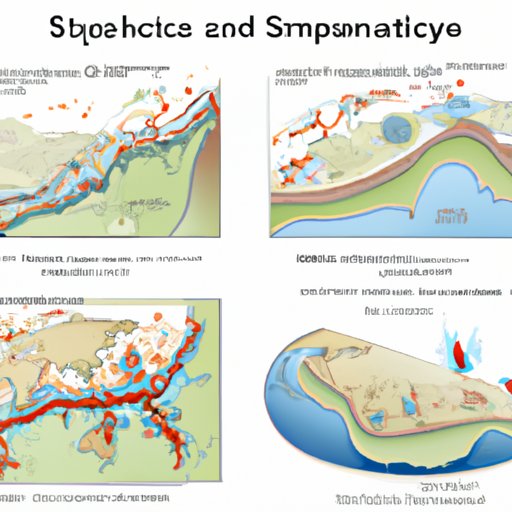Introduction
Have you ever heard of a subduction zone? If you’re not up-to-date with your geography or earth science lessons, you may not be familiar with this term. A subduction zone occurs when one of the tectonic plates that make up the earth’s crust moves beneath another plate. Understanding subduction zones is essential for anyone living in regions where they occur, as they can often lead to natural disasters.
The Science of Subduction Zones: Understanding the Earth’s Tectonic Plates
The earth’s crust is composed of numerous plates that are constantly moving. These plates move due to the movement of molten rock and minerals underneath the surface. As the plates move, they can collide, slide past each other, or even move away from each other.
In the case of a subduction zone, one of the plates moves beneath another plate. This process is known as subduction and occurs due to the difference in density between the plates. The denser plate, known as the oceanic plate, moves beneath the less dense plate, known as the continental plate.
This process often results in earthquakes and volcanic eruptions due to the movement of the plates and the buildup of pressure.
How Subduction Zones Shape the Earth’s Geography: A Comprehensive Guide
Subduction zones can have a significant impact on the earth’s geography. When an oceanic plate moves beneath a continental plate, it can cause the continental plate to buckle and form mountain ranges. The Andes Mountains in South America are an example of mountains formed by subduction.
Subduction zones can also form islands. As the oceanic plate moves beneath the continental plate, it can cause the release of magma, which can lead to volcanic eruptions. Over time, these volcanic eruptions can result in the creation of islands. The Japanese islands are an example of islands formed by subduction.
In addition to these processes, subduction zones can also cause changes in the earth’s crust. The movement of the plates can result in the formation of faults, areas where the earth’s crust has cracked or shifted.
From Mountains to Earthquakes: Exploring Subduction Zones
While subduction zones can lead to the creation of beautiful geographical features, they can also result in natural disasters such as earthquakes. When two plates move against each other, it can cause a buildup of pressure. This buildup of pressure can eventually result in an earthquake.
Areas near subduction zones are especially at risk for earthquakes. These earthquakes can range in severity from mild tremors to devastating earthquakes that can cause significant damage and loss of life.
Despite the risks associated with living near subduction zones, many people choose to make these areas their homes. For example, in the United States, the Pacific Northwest region is a subduction zone. Despite this, millions of people choose to live in this region.
The Role of Subduction Zones in Natural Disasters and Climate Change
In addition to earthquakes, subduction zones can also contribute to other natural disasters. The release of magma during subduction can lead to volcanic eruptions. These eruptions can result in ash clouds that can impact air travel and the health of people in the surrounding areas.
Subduction zones can also contribute to climate change. The movement of plates can cause carbon to be released from the earth’s crust. Over time, this release of carbon can contribute to global warming and climate change.
A Deeper Dive into Subduction Zones: How Scientists Study Plate Interactions
Scientists use a variety of technologies to study subduction zones. One of the most common is seismology, the study of earthquakes and seismic waves. Seismologists use seismometers to detect and measure seismic waves, which can provide information about the location and movement of tectonic plates.
Scientists also use satellites to monitor the movement of the earth’s crust. Satellites can provide data on plate movements, volcanic activity, and other geological processes.
Recent advancements in technology have also allowed scientists to study subduction zones in greater detail. For example, scientists have used submersibles to explore subduction zones on the ocean floor.
Exploring the Impacts of Subduction Zones on Our Oceans and Marine Life
Subduction zones can impact not only the earth’s geography and climate but also the world’s oceans. The movement of plates can cause changes in ocean currents, which can impact the distribution of nutrients and marine life.
Subduction zones can also create underwater mountains and ridges, which can provide habitat for marine life. In addition, subduction zones can result in the release of chemicals and minerals into the ocean, which can impact the health of marine ecosystems.
Conclusion
Subduction zones may not be a topic that everyone is familiar with, but they play a significant role in the earth’s processes. Understanding subduction zones is essential for anyone living in regions where they occur, as they can often lead to natural disasters such as earthquakes and volcanic eruptions.
While subduction zones can have negative impacts on our planet, they also play a vital role in the formation of mountains, islands, and other geographical features. As scientists continue to study subduction zones, we will gain a better understanding of our planet and the forces that shape it.
